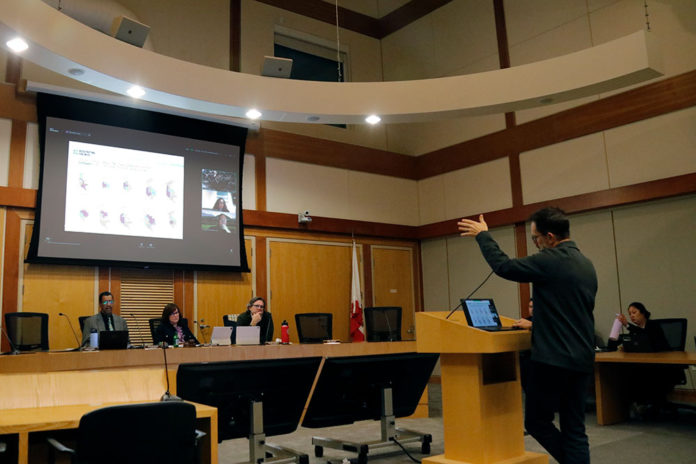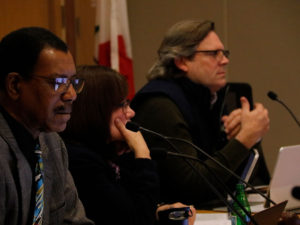
The third public meeting held in the effort to split Healdsburg’s electorate into districts, to satisfy the requirements of California’s Voting Rights Act, led to a general consensus among the council members to stick with their original preference: five districts each to elect a councilmember, with the mayor’s role rotating between them.
Paul Mitchell, the president of the consultant Healdsburg hired to navigate the process, Redistricting Partners, returned to the podium for the first time since the first public hearing in December to walk the council through three proposed maps.

Each was a five-district map, with an emphasis on accomplishing the goals of building districts—keeping communities of interest together, geographical contiguity, population balance and various degrees of racial or economic equality.
Redistricting Partners developed the three maps Mitchell proposed by using the same tools and data that Healdsburg’s residents did when they also created maps, using the DistrictR online software. Community involvement in the process was relatively high, with a total of 78 maps produced by the public.
Of those, 39 were five-district maps, as preferred by the council from the first meeting onward. But 26 of the maps proposed four-district divisions, and another 12 maps, six districts (and one for a single district only). The 38 even-numbered districts plans implicitly prescribe an elected mayor, elected “at large” by the whole city.
Five Districts?
Notably, adding the odd-numbered district maps together indicated the city itself is almost evenly split on the question of an elected mayor (which would be necessary to create an odd-numbered council to prevent tie votes).
But Mitchell presented only the three five-district maps, which focused primarily on accomplishing even population parity, as well as age and Hispanic demographics. However, the council members addressed many of their concerns to preserving neighborhoods, such as Fitch Mountain Villas and along the river. Consultant Mitchell did not seem, however, initially attentive to the location of the Plaza, and didn’t seem to know where it was on the map.
The 10 people who turned out for the public hearing made only a handful of public comments, though all five of them appeared to favor an elected mayor for a variety of reasons.
“I feel the public has never heard any substantive discussion of four or six districts,” said Merrilyn Joyce, adding that “the powers that be have channeled this process to a five-district, rotating mayor” solution.
Hank Skewis expressed similar concerns. “I have more interest in an at-large mayor than a rotating mayor, less so the number of districts,” he said.
If that were true, it didn’t change at Tuesday nights’ council meeting. Councilmember Ron Edwards, referring yet again to his practice of knocking on every door when he ran for the seat, observed that while running for a district seat would not be prohibitively costly, running for a once-every-two-year mayor’s office would be expensive—and potentially preclude lower-income candidates from attempting the race.
Rotating Mayor?
“Fundamentally I just can’t find myself agreeing with an elected mayor,” said Mayor Evelyn Mitchell, appointed in December for a one-year term. “It would fly in the face of what we’re doing here.” She added that “at some point we need to put this to rest.”
“You can be a council member, but you’ll never be mayor,” he said, personalizing the challenge of entering political life for low-income residents.
Though Councilmember Ariel Kelley, Zooming from Kihei, Hawaii (just as Chris Herrod likewise Zoomed from Athens, Ohio), had been the most open to the idea of an at-large mayor, she ultimately supported her colleagues in the five-district, rotating mayor scenario.
“It’s certainly not a hill I want to die on,” she said.
Added to the three maps that Redistricting Partners proposed was a fourth, which Councilmember Chris Herrod dug up from the public submissions and presented as another candidate. After further discussion and tweaking of its districts to comport with the required parameters, it was added to the short list of proposed maps as Map D.
The next public hearing of the transition to district elections will take place in one month, on March 17. Additional public-generated maps can be submitted until that date, or a week before it to be considered in the fourth public hearing.
The fifth and final public hearing, and the council’s decision on a new district map for the City of Healdsburg, will take place on April 7.
Information on the process, and a link for the proposed maps and the mapmaking tool, can be found at healdsburg.gov/districtelections.








It seemed like much of the night was spent talking about race and equity. This is didn’t make sense because the fair districting rules strictly prohibit using race as the determining factor in drawing up district boundaries. Three of the five maps chosen had one of the current council members representing the southern district even though none of the members live south of North Street. Even though there was a lot of talk about equity, the council really seemed more concerned with keeping their current power base. Last night 100% of the people who spoke were in favor of an at large mayor. In the previous meetings it had been about 90% in favor, yet Mayor Mitchell said she has not heard from any residents who wanted an at large mayor. Much like Measure O, the council will go forward with their own agenda despite what residents want. I don’t like what I’m seeing with this process, and unlike Measure O, the voters will not have the final say.
How do we prevent the council from doing what They want rather than what the people of Healdsburg want??